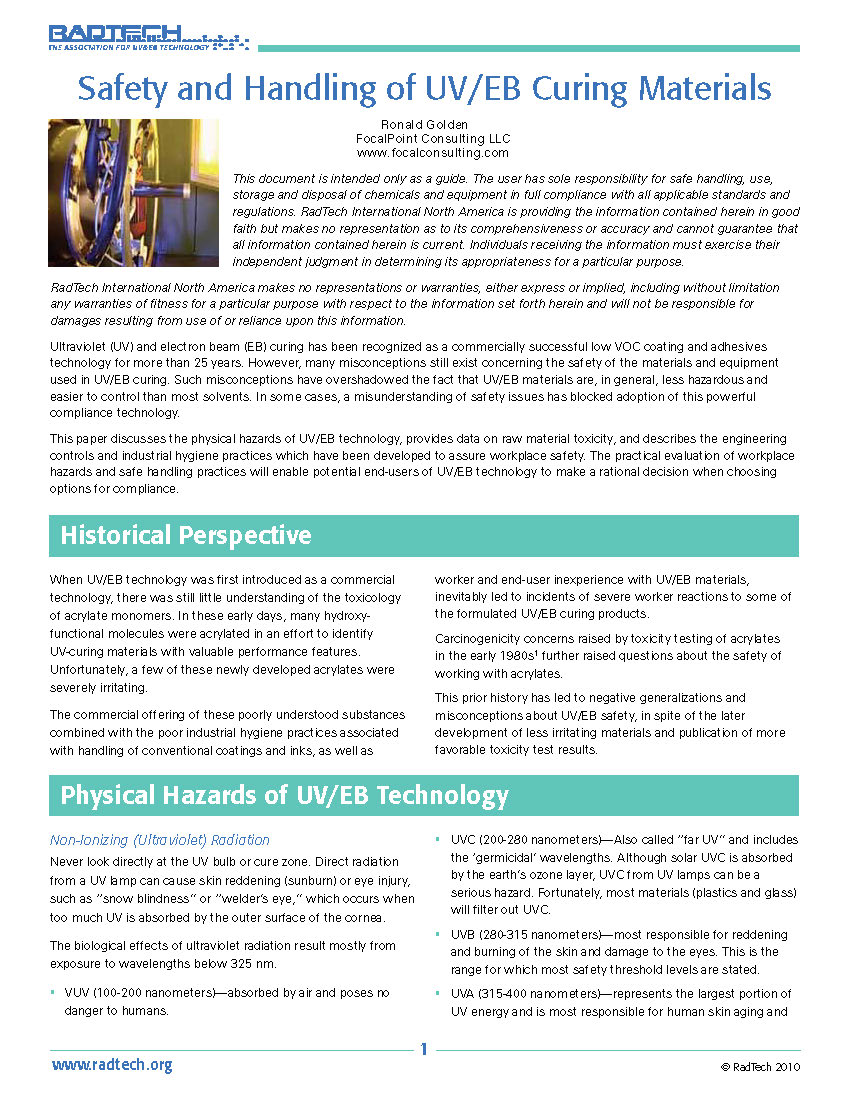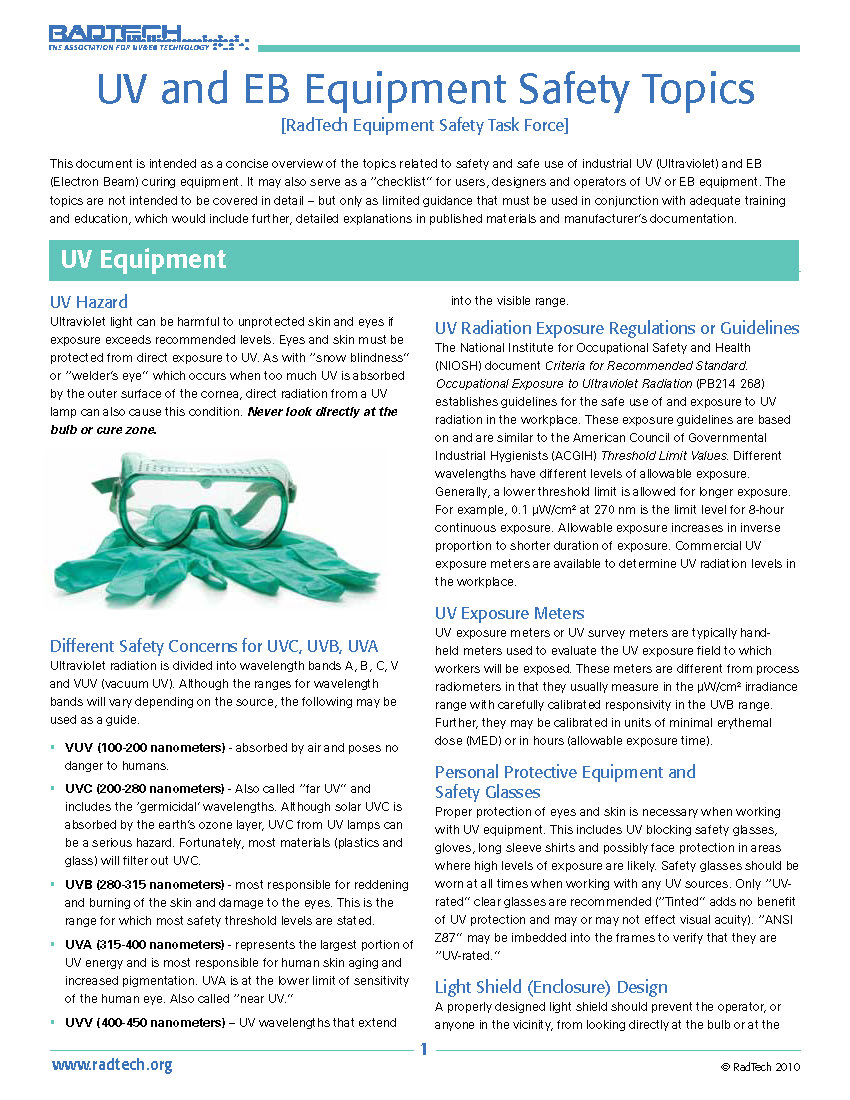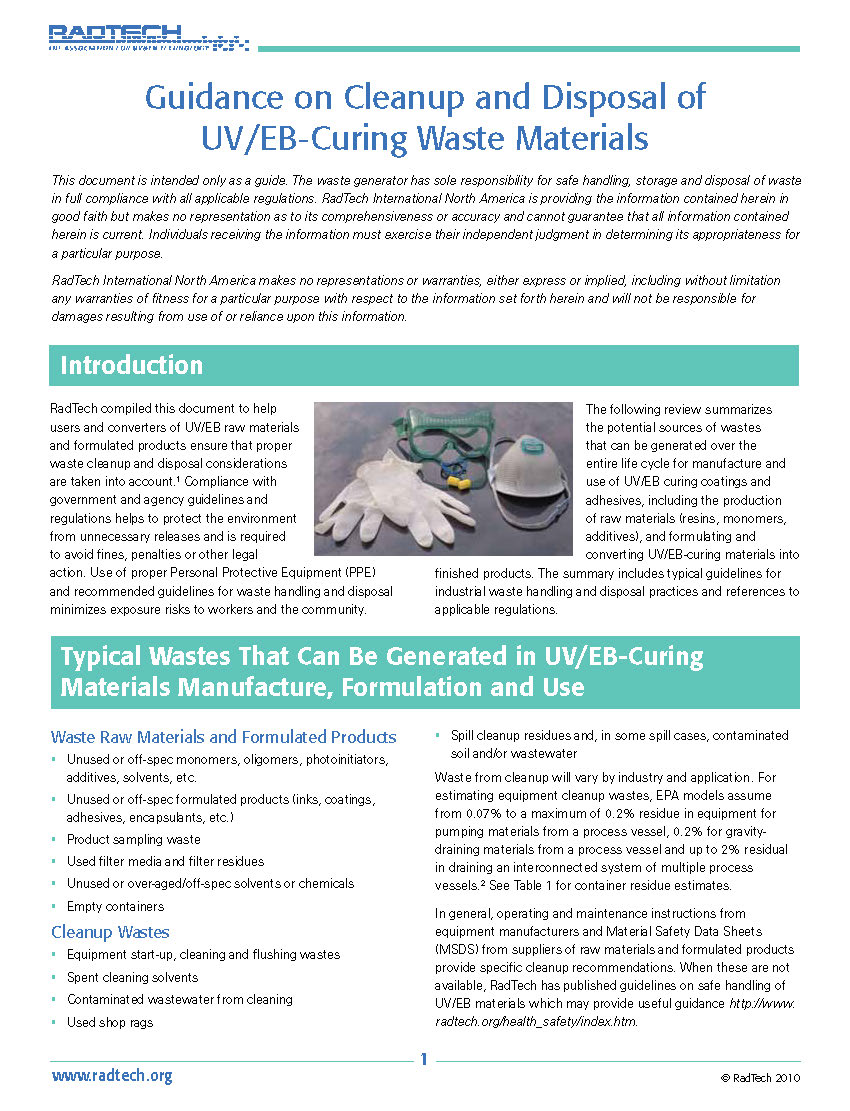General Health & Safety
UV/EB technology has been shown to be safe to use in manufacturing and in sensitive applications.
Like any other industrial technology, safe use of UV/EB curing requires an understanding of the potential hazards, training and adherence to good safety and hygiene practices. UV/EB-curing materials are generally less hazardous than solvents in the work environment. UV/EB-curing materials have low systemic toxicity, and acrylates as a class have been shown not to be carcinogenic via dermal and oral exposure. Good industrial hygiene practices, knowledge of safe handling procedures and worker training are essential for safe handling of any chemical. When these principles are followed, experience has shown that UV/EB-curing technology can be handled safely in widely varying industrial applications.
For packaging applications, food safety is very important. In many situations, low-migration UV-curable inks can be used for indirect food contact applications.
Material & Equipment Safety
Safety & Handling of UV/EB Materials Videos
A six-video series that includes an overview of the safe use and handling of UV/EB formulations through engineering controls, personal protective equipment and good work practices.
2010. Ron Golden. RadTech Fact Sheet
This paper describes the engineering controls and industrial hygiene practices which have been developed to assure workplace safety.
RadTech
This document is a guideline for the handling of UV/EB raw materials and processing equipment. It is the responsibility of the users to read and understand Material Safety Data Sheets (now referred to as Safety Data Sheets), labels and process equipment instructions.
2010. RadTech Equipment Safety Task Force. RadTech Fact Sheet.
This document is a concise overview of the topics related to safety and safe use of industrial UV and EB curing equipment. It may also serve as a “checklist” for users, designers and operators of UV or EB equipment. The topics are not intended to be covered in detail — but only as limited guidance that must be used in conjunction with adequate training and education, which would include further, detailed explanations in published materials and manufacturer’s documentation.
Food Safety
Low-Migration, UV-Curable Inkjet Printing Inks for Packaging Applications.
2012. Roel DeMondt. RadTech Report, Issue 3.
This technical paper discusses a low-viscous ink formulation developed based upon the use of a combination of specific polymerisable compounds and photoinitiators, resulting in a very high degree of crosslinking and low amounts of migratables. When combined with a highly efficient printing engine, the formulation can create a reliable printing solution for safe food packaging.
UV/EB Coatings & Food Contact Applications
2012.
Misconceptions about the use of UV/EB coatings in food contact applications abound. This information sheet gives an overview of the Food and Drug Administration regulations for food packaging, the no-migration exemption and threshold of regulation policy.
Application Safety
New Studies Examine Safety of UV Curing for Fingernail Coatings
2013. Doug Schoon. RadTech Report, Issue 3
Nail salon, professional-use only, UV artificial nail-curing lamps were recently evaluated in two independent studies and determined safe and not an actinic UV risk to skin or eyes under the conditions of use.hich would include further, detailed explanations in published materials and manufacturer’s documentation.
2014. Doreen M. Monteleone, RadTech, Neal Cohen, CPSC & Mary Toro, CPSC
Hear directly from product safety professionals from the U.S. Consumer Product Safety Commission (CPSC). They provide a detailed presentation followed by a question and answer session about the applicability of federal safety laws (mandatory and voluntary) including the Consumer Products Safety Improvement Act (CPSIA) to the UV/EB industry.
Regulatory Implications for UV/EB-cured Coatings Used in Packaging Children’s Products
The Consumer Product Safety Commission (CPSC) does not expressly regulate packaging materials. It may, however, regulate consumer products packaging if the package itself has a practical use (e.g., buckets) or has some play value to children. This article discusses the regulatory program administered by the Food and Drug Administration (FDA) for food packaging provides useful guidance concerning the exposure of children to hazards in packaging. Based on these regulations the use of such packaging materials in food applications, properly cured UV/EB coatings can be used safely in packaging of children’s products.
RadTech International North America | The Association for Ultraviolet and Electron Beam Technologies
6935 Wisconsin Ave, Suite 207, Chevy Chase, MD 20815 | (240) 497-1242 | uveb@radtech.org



